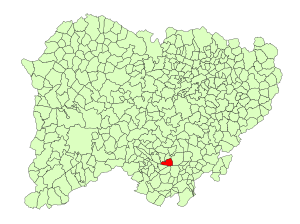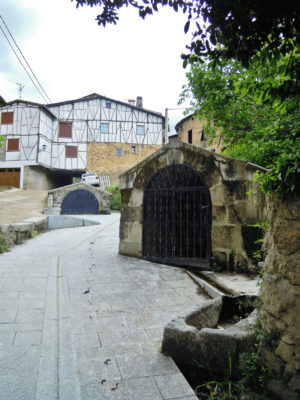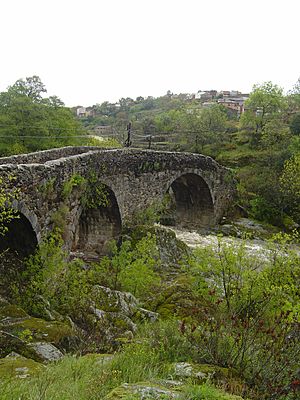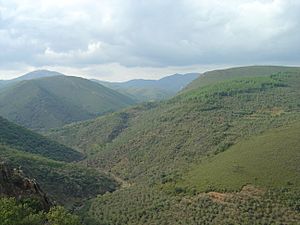San Esteban de la Sierra facts for kids
Quick facts for kids
San Esteban de la Sierra
|
|
|---|---|
 |
|

Location in Salamanca
|
|
| Country | Spain |
| Autonomous community | Castile and León |
| Province | Salamanca |
| Comarca | Sierra de Francia |
| Area | |
| • Total | 21 km2 (8 sq mi) |
| Elevation | 623 m (2,044 ft) |
| Population
(2018)
|
|
| • Total | 347 |
| • Density | 16.5/km2 (42.8/sq mi) |
| Time zone | UTC+1 (CET) |
| • Summer (DST) | UTC+2 (CEST) |
| Postal code |
37671
|
San Esteban de la Sierra is a small village and municipality in western Spain. It is part of the Salamanca province in the Castile and León region. You can find it about 65 kilometers (40 miles) from the city of Salamanca. This charming village is home to around 340 people.
Contents
A Glimpse into San Esteban's Past
San Esteban de la Sierra has a long and interesting history. Records show that people settled here as early as the 12th century. Families came looking for water to power their mills. Over time, a Jewish community grew in the area.
Later, in the 15th century, after the Jewish and Muslim people left, Christians rebuilt the village. They used the same spot where the old Jewish quarter once stood. This shows how different cultures have shaped the village over hundreds of years.
Exploring San Esteban's Geography
San Esteban de la Sierra is nestled on a mountainside. It is surrounded by several beautiful mountains. One special mountain is Tiriñuelo. It gives its name to a local wine that won a big award in 1997!
The village covers an area of about 22 square kilometers (8.5 square miles). A large part of this land is used for growing grapes. The people of San Esteban are very proud of their wine. Making wine is the most important industry here.
The river Alagón flows through the lower part of the town. It winds its way through the mountains before joining the larger Tagus river. San Esteban de la Sierra sits 623 meters (2,044 feet) above sea level.
The Village's Unique Language History
People in San Esteban de la Sierra and the nearby village of Santibañez de la Sierra once spoke a special dialect. This dialect was a form of Leonese. Sadly, this old way of speaking is no longer used every day.
However, some parts of the old dialect still remain. For example, you might hear certain sounds or word endings that are unique to this area. Some words even come from very old languages like Mozarab and Basque. These special words have been passed down since the Middle Ages.
Who Lives in San Esteban?
In 2011, about 365 people lived in San Esteban de la Sierra. There were slightly more men (187) than women (178). The village covers an area of about 20.83 square kilometers (8.04 square miles).
Like many small villages, San Esteban has seen some people move to bigger cities. This has caused the population to go down a bit. But during holidays like Christmas, Easter, and summer, the village comes alive! Many people who grew up here, or their families, come back to visit.
Fun Feasts and Celebrations
San Esteban de la Sierra loves to celebrate! They have several exciting feasts throughout the year.
Saint Agatha's Feast (February 5)
This feast is a special tradition. Some men are chosen as 'butlers' for the day. They work in pairs to make delicious traditional sweets. These include perrunillas and sacatrapos. They also make drinks like anisette.
The night before the feast, the 'butlers' share these treats with everyone. On February 5th, there's a church service. Then, the 'butlers' dress in traditional clothes and parade through the streets. They even recite poems about Saint Agatha! After the parade, they enjoy a big meal together.
The next day, the 'butlers' have lunch at the town hall. They eat a special dish called limón. This dish is a local favorite! It's made with lemon, orange, roasted meat, chorizo, fried and boiled eggs, oil, pickles, and wine.
Saint Stephen's Feast (August 3)
This feast honors the village's patron saint, Saint Stephen (San Esteban). The village is even named after him! This used to be the biggest celebration. However, it takes place during the grape harvest season. This is a very busy time for the village, as wine is so important here.
Because of this, another feast, the 'Feast of Christ,' became more popular. But Saint Stephen's Feast is still celebrated! The local wine cooperative company helps keep it alive. They organize a big dinner for everyone, with music and parties. It's a smaller feast, but more and more tourists are joining in during their summer holidays.
The Feast of Christ (September 4)
This is the biggest and most lively feast in San Esteban! People of all ages form peñas, which are like party groups. They gather in special places to celebrate. They often open their doors to visitors, offering drinks and fun.
The feast kicks off with the crowning of the Queens of the feast and their maids. Then comes the exciting quema del castillo, or "burning of the Castle." This old tradition involves young men climbing a tall, branchless tree. Bonfires burn below, making it a thrilling challenge! The winner gets a smoked ham.
For five days, the village is full of parties, banquets, plays, and live music. On the last day, there's a parade with decorated floats. Later, a bullfighting show takes place in the Main Square. The feast ends with a final party after midnight, with wine, local foods, and music.
San Esteban's Rich Heritage
San Esteban de la Sierra has grown a lot recently. It now has more places for visitors to stay, like guest houses. New bars, restaurants, and shops selling local products have also opened.
The village is home to several old Romanesque buildings. These include the village chapel and the Church of St Stephen. There's also a medieval bridge over the Alagón river, known as the Roman Bridge.
The way the village streets are laid out today still follows the plan of the old Jewish quarter. Many traditional houses are made from wood and adobe (a type of sun-dried brick). They are built along small, winding streets. Much of the town slopes downhill, showing how close it is to the river.
San Esteban de la Sierra is located in a beautiful valley. It is surrounded by thick forests of chestnut and eucalyptus trees. You can also see olive groves and vineyards on the hillsides. The natural beauty here is a big draw for visitors. Many people come to enjoy hiking through the valley.
The village is about 20 kilometers (12 miles) from Sierra de Francia. It is also close to other interesting villages like San Martín del Castañar, La Alberca, Miranda del Castañar, and the town of Bejar. The famous Peña de Francia mountain is also nearby.
See also
 In Spanish: San Esteban de la Sierra para niños
In Spanish: San Esteban de la Sierra para niños




